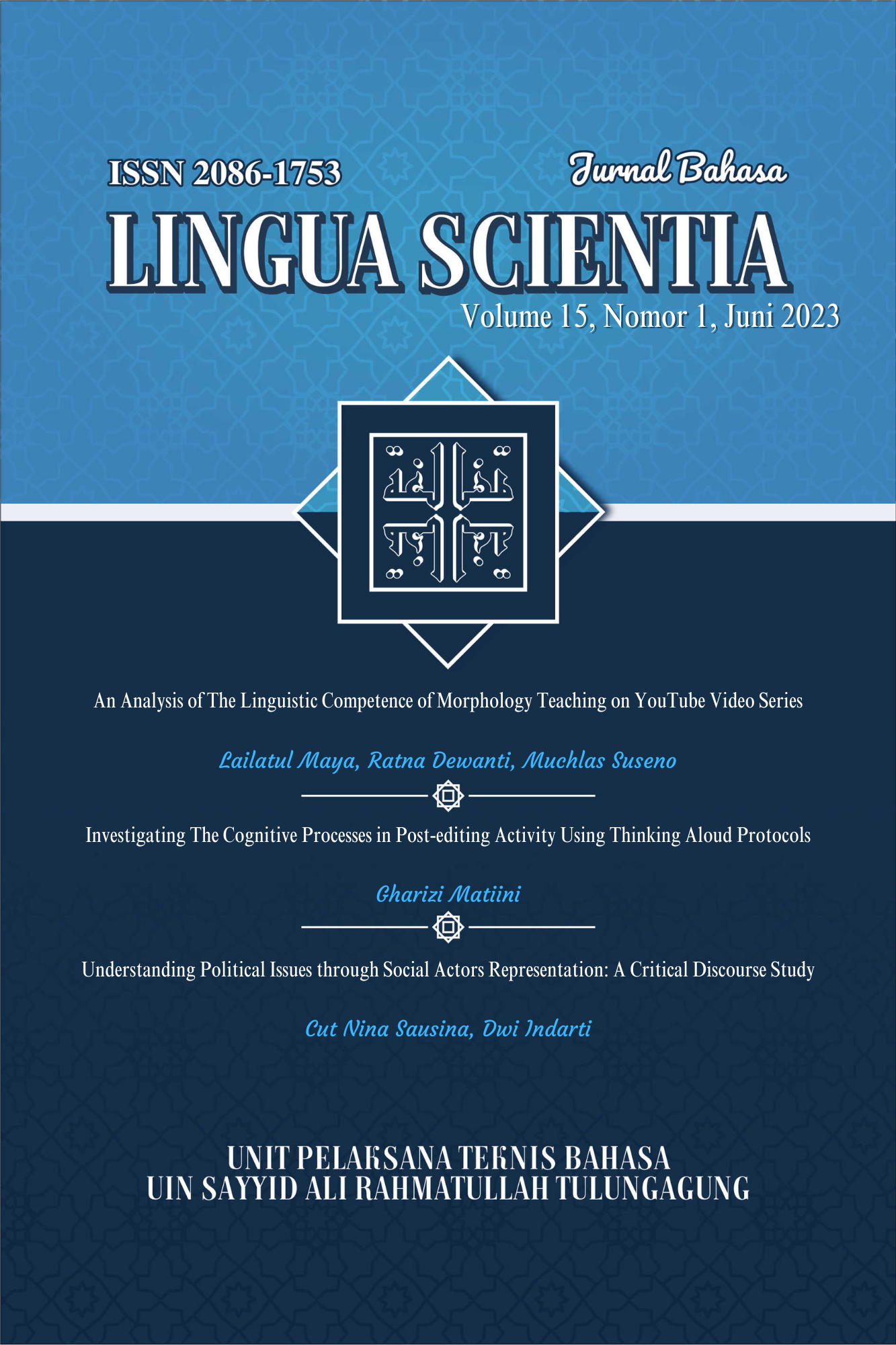AN ANALYSIS OF THE LINGUISTIC COMPETENCE OF MORPHOLOGY TEACHING ON YOUTUBE VIDEO SERIES
Abstract
Linguistic competence has had a significant influence on English language teaching. Linguistic competence is largely concerned with a notion shared by language teachers and learners when using language knowledge in real performance. English teachers are expected to have this competency. The present study aimed to examine linguistic competence in morphology teaching, which was demonstrated by an English teacher. The morphology teaching was sourced from a series of YouTube videos which were broadcast by a teacher on a Youtube channel. This study was carried out by analyzing the linguistic competence of the teacher in each video by analogizing the teacher’s knowledge with the theory from the linguistics book written by some experts. The selected books which were used to analyze were: “How English Works, A Linguistic Introduction” (Curzan & Adams, 2012); “Linguistics, An Introduction” (Radford et al., 2009); and “Contemporary Linguistic Analysis, An Introduction” (O’Grady & Archibald, 2016). The study’s findings revealed that the teacher had sufficient linguistic competence while delivering the course. The findings also assisted in recognizing that linguistic competence is a significant part of the analysis in terms of how a teacher may remain competent while providing the course. In short, linguistics is considered valuable because it may increase teacher’s awareness of language, making the teacher more competent and, hence, a better language teacher.
Downloads
References
Alshurafat, H., Beattie, C., Jones, G., & Sands, J. (2020). Perceptions of the usefulness of various teaching methods in forensic accounting education. Accounting Education, 29(2), 177–204. https://doi.org/10.1080/09639284.2020.1719425
Chathamkulam Abdulrahman, N., & Abu-Ayyash, E. A. S. (2019). Linguistic Competence, Communicative Competence and Interactional Competence. International Journal of Computers & Technology, 19(November), 7537–7552. https://doi.org/10.24297/ijct.v19i0.8505
Curzan, A., & Adams, M. J. (2012). How English Work, A Linguistic Introduction. Pearson Education Inc.
Ernest, P., Guitert Catasús, M., Hampel, R., Heiser, S., Hopkins, J., Murphy, L., & Stickler, U. (2013). Online teacher development: Collaborating in a virtual learning environment. Computer Assisted Language Learning, 26(4), 311–333. https://doi.org/10.1080/09588221.2012.667814
Fillmore, L. W., & Snow, C. E. (2000). What Teachers Need to Know About Language. Center for Applied Linguistics.
Finch, G. (2003). How to Study Linguistics. In How to Study Linguistics. https://doi.org/10.1007/978-0-230-80213-1
Golonka, E. M., Bowles, A. R., Frank, V. M., Richardson, D. L., & Freynik, S. (2014). Technologies for foreign language learning: A review of technology types and their effectiveness. Computer Assisted Language Learning, 27(1), 70–105. https://doi.org/10.1080/09588221.2012.700315
Gràcia, M., Adam, A. L., Carbó, M., Rouaz, K., & Astals, M. (2018). Comunicational and oral competences in initial teacher training. Pensamiento Educativo, 55(2), 1–16. https://doi.org/10.7764/PEL.55.2.2018.3
Gràcia, M., Alvarado, J. M., & Nieva, S. (2021). Assessment of oral skills in adolescents. Children, 8(12), 1–15. https://doi.org/10.3390/children8121136
Gràcia, M., Casanovas, J., Riba, C., Sancho, M. R., Jarque, M. J., Casanovas, J., & Vega, F. (2020). Developing a digital application (EVALOE-DSS) for the professional development of teachers aiming to improve their students’ linguistic competence. Computer Assisted Language Learning, 0(0), 1–26. https://doi.org/10.1080/09588221.2019.1707690
Gruba, P. (2004). Designing tasks for online collaborative language learning. Prospect, 19(2), 72–81.
Hamre, B., Hatfield, B., Pianta, R., & Jamil, F. (2014). Evidence for General and Domain-Specific Elements of Teacher-Child Interactions: Associations With Preschool Children’s Development. Child Development, 85(3), 1257–1274. https://doi.org/10.1111/cdev.12184
Jeong, K. O. (2017). Preparing EFL student teachers with new technologies in the Korean context. Computer Assisted Language Learning, 30(6), 488–509. https://doi.org/10.1080/09588221.2017.1321554
Khansir, A. A. (2013). Applied linguistics and english language teaching. Middle East Journal of Scientific Research, 15(8), 1140–1146. https://doi.org/10.5829/idosi.mejsr.2013.15.8.11238
Kharchenko, T., Semashko, T., Dolynskiy, I., Bespala, L., & Ivanova, T. (2021). Use of moodle lms-based tests for enhancing linguistic competence of students majoring in foreign language philology. Journal of Curriculum and Teaching, 10(4), 67–81. https://doi.org/10.5430/jct.v10n4p67
Liu, B., & Biao, J. (2021). Strategic Evolution of Language Education Policy in the Information Age. Journal of Physics: Conference Series, 1744(3). https://doi.org/10.1088/1742-6596/1744/3/032043
Lucas, T., Villegas, A. M., & Freedson-Gonzalez, M. (2008). Linguistically Responsive teacher education: Preparing classroom teachers to teach english language learners. Journal of Teacher Education, 59(4), 361–373. https://doi.org/10.1177/0022487108322110
Martinez del Castillo, J. (2016). Studying Linguistic Competence The Problem. Education and Linguistics Research, 2(1), 85. https://doi.org/10.5296/elr.v2i1.9157
Martínez del Castillo, J. (2013). Modes of Thinking , Language and Linguistics.
Mashburn, A. J. (2008). Quality of social and physical environments in preschools and children’s development of academic, language, and literacy skills. Applied Developmental Science, 12(3), 113–127. https://doi.org/10.1080/10888690802199392
Mercer, S., MacIntyre, P., Gregersen, T., & Talbot, K. (2018). Positive language education: Combining positive education and language education. Theory and Practice of Second Language Acquisition, 4(2), 11–31.
O’Grady, W., & Archibald, J. (2016). Contemporary Linguistic Analysis; an Introduction (Eight Edit). Pearson. http://www.pearsoned.ca/text/ogrady/
Quintana-Lara, M. (2014). Effect of Acoustic Spectrographic Instruction on production of English /i/ and /I/ by Spanish pre-service English teachers. Computer Assisted Language Learning, 27(3), 207–227. https://doi.org/10.1080/09588221.2012.724424
Radford, A., Atkinson, M., Britain, D., Clahsen, H., & Spencer, A. (2009). Linguistics an Introduction. In ثبثبثب (Second Edition, Issue ثق ثقثقثق). Cambridge University Press.
Shaykhislamov, N. Z. ugli, & Makhmudov, K. S. ugli. (2020). Linguistics and Its Modern Types. Academic Research in Educational Sciences, 1(1), 9–25.
Smythe, S., & Neufeld, P. (2010). “Podcast Time”: Negotiating Digital Literacies and Communities of Learning in a Middle Years ELL Classroom. Journal of Adolescent & Adult Literacy, 53(April), 565–574. https://doi.org/10.1598/JA
Syarif, H. (2016). Linguistics and the English Language Instruction. Lingua Didaktika: Jurnal Bahasa Dan Pembelajaran Bahasa, 10(1), 50. https://doi.org/10.24036/ld.v10i1.6328
Tahir, I. (2018). Teachers ’ Beliefs in Balancing Linguistic Competence and Teaching Performance in EFL Classrooms. BRAIN. Broad Research in Artificial Intelligence and Neuroscience, 9(1), 50–58.
Varpe, M. G. (2013). Linguistic and Communicative Competence. International Journal of English and Literature (IJEL), 3(2), 347. https://doi.org/10.2307/3585467
Copyright (c) 2023 Lailatul Maya, Ratna Dewanti, Muchlas Suseno

This work is licensed under a Creative Commons Attribution-NonCommercial 4.0 International License.
Before going to review process, all manuscripts will be checked that they are free from plagiarism practice using "Turnitin" software. If there is an indication of plagiarism, the manuscript will instantly be rejected.


